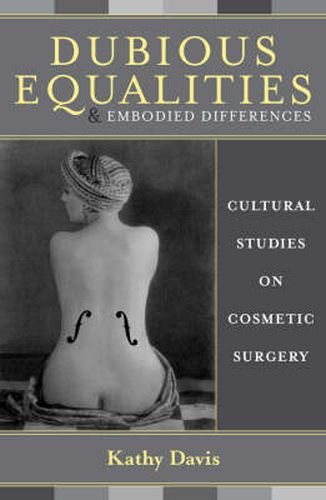Readings Newsletter
Become a Readings Member to make your shopping experience even easier.
Sign in or sign up for free!
You’re not far away from qualifying for FREE standard shipping within Australia
You’ve qualified for FREE standard shipping within Australia
The cart is loading…






Dubious Equalities and Embodied Differences explores cosmetic surgery as a cultural phenomenon of late modernity. From its onset as medical specialty at the end of the 19th century, cosmetic surgery has been intimately linked to discourses of normalcy as well as gender, race and other categories of difference. This link has shaped its technologies and techniques, its professional ideologies, and the objects of its interventions. Kathy Davis shows how cosmetic surgery is represented in medicine and popular culture, drawing upon a wide range of examples taken from the media, music, performance art, literature, public debates and medical texts. She uses her own uneasiness about the ubiquitous erasure of difference under the spurious banner of equality as symptomatic of the cosmetic surgery culture. Davis proposes an approach which takes embodied difference (collective and biographical), the experience of suffering, and an appreciation of individuals’ capacity for agency even under less-than-perfect circumstances as starting points for thinking about the normative issues involved in cosmetic surgery. Cosmetic surgery in a different voices; lonely heroes and great white clouds; the rhetoric of cosmetic surgery; surgical stories; surgical passing; my body is my art ; a dubious equality .
$9.00 standard shipping within Australia
FREE standard shipping within Australia for orders over $100.00
Express & International shipping calculated at checkout
Dubious Equalities and Embodied Differences explores cosmetic surgery as a cultural phenomenon of late modernity. From its onset as medical specialty at the end of the 19th century, cosmetic surgery has been intimately linked to discourses of normalcy as well as gender, race and other categories of difference. This link has shaped its technologies and techniques, its professional ideologies, and the objects of its interventions. Kathy Davis shows how cosmetic surgery is represented in medicine and popular culture, drawing upon a wide range of examples taken from the media, music, performance art, literature, public debates and medical texts. She uses her own uneasiness about the ubiquitous erasure of difference under the spurious banner of equality as symptomatic of the cosmetic surgery culture. Davis proposes an approach which takes embodied difference (collective and biographical), the experience of suffering, and an appreciation of individuals’ capacity for agency even under less-than-perfect circumstances as starting points for thinking about the normative issues involved in cosmetic surgery. Cosmetic surgery in a different voices; lonely heroes and great white clouds; the rhetoric of cosmetic surgery; surgical stories; surgical passing; my body is my art ; a dubious equality .